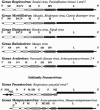Animal pneumoviruses: molecular genetics and pathogenesis
- PMID: 15084507
- PMCID: PMC387412
- DOI: 10.1128/CMR.17.2.390-412.2004
Animal pneumoviruses: molecular genetics and pathogenesis
Abstract
Pneumoviruses are single-stranded, negative-sense, nonsegmented RNA viruses of the family Paramyxoviridae, subfamily Pneumovirinae, and include pathogens that infect humans (respiratory syncytial virus and human metapneumovirus), domestic mammals (bovine, ovine, and caprine respiratory syncytial viruses), rodents (pneumonia virus of mice), and birds (avian metapneumovirus). Among the topics considered in this review are recent studies focused on the roles of the individual virus-encoded components in promoting virus replication as well as in altering and evading innate antiviral host defenses. Advances in the molecular technology of pneumoviruses and the emergence of recombinant pneumoviruses that are leading to improved virus-based vaccine formulations are also discussed. Since pneumovirus infection in natural hosts is associated with a profound inflammatory response that persists despite adequate antiviral therapy, we also review the recent experimental treatment strategies that have focused on combined antiviral, anti-inflammatory, and immunomodulatory approaches.
Figures



References
-
- Abu-Harb, M., F. Bell, A. Finn, W. H. Rao, L. Nixon, D. Shale, and M. L. Everard. 1999. IL-8 and neutrophil elastase levels in the respiratory tract of infants with RSV bronchiolitis. Eur. Respir. J. 14:139-143. - PubMed
-
- Adah, S. A., S. F. Bayly, H. Cramer, R. H. Silverman, and P. F. Torrence. 2001. Chemistry and biochemistry of 2′,5′-oligoadenylate-based strategy. Curr. Med. Chem. 8:1189-1212 - PubMed
-
- Ahmad, A., J. Davies, S. Randall, and G. R. Skinner. 1996. Antiviral properties of extract of Opuntia streptacantha. Antiviral Res. 30:75-85. - PubMed
-
- Ahmadian, G., P. Chambers and A. J. Easton. 1999. Detection and characterization of proteins encoded by the second ORF of the M2 gene of pneumoviruses. J. Gen. Virol. 80:2011-2016. - PubMed
-
- Alvarez, R., H. M. Lwamba, D. R. Kapczynski, M. K. Njenga, and B. S. Seal. 2003. Nucleotide and predicted amino acid sequence-based analysis of the avian metapneumovirus type C cell attachment glycoprotein gene: phylogenetic analysis and molecular epidemiology of the U.S. pneumoviruses. J. Clin. Microbiol. 41:1730-1735. - PMC - PubMed
Publication types
MeSH terms
Substances
LinkOut - more resources
Full Text Sources
Other Literature Sources

